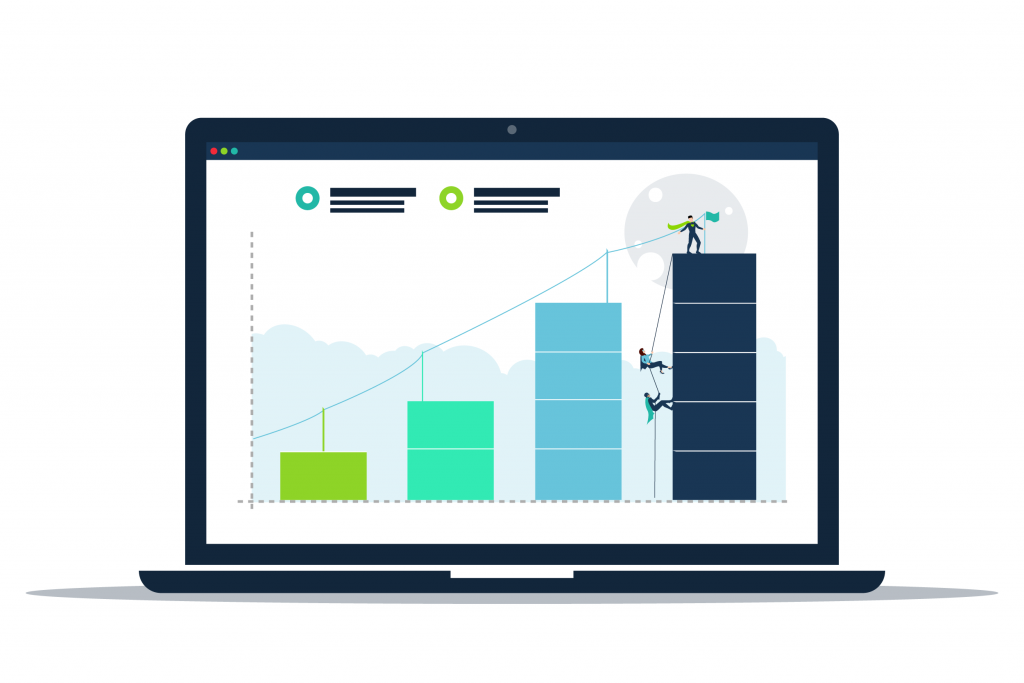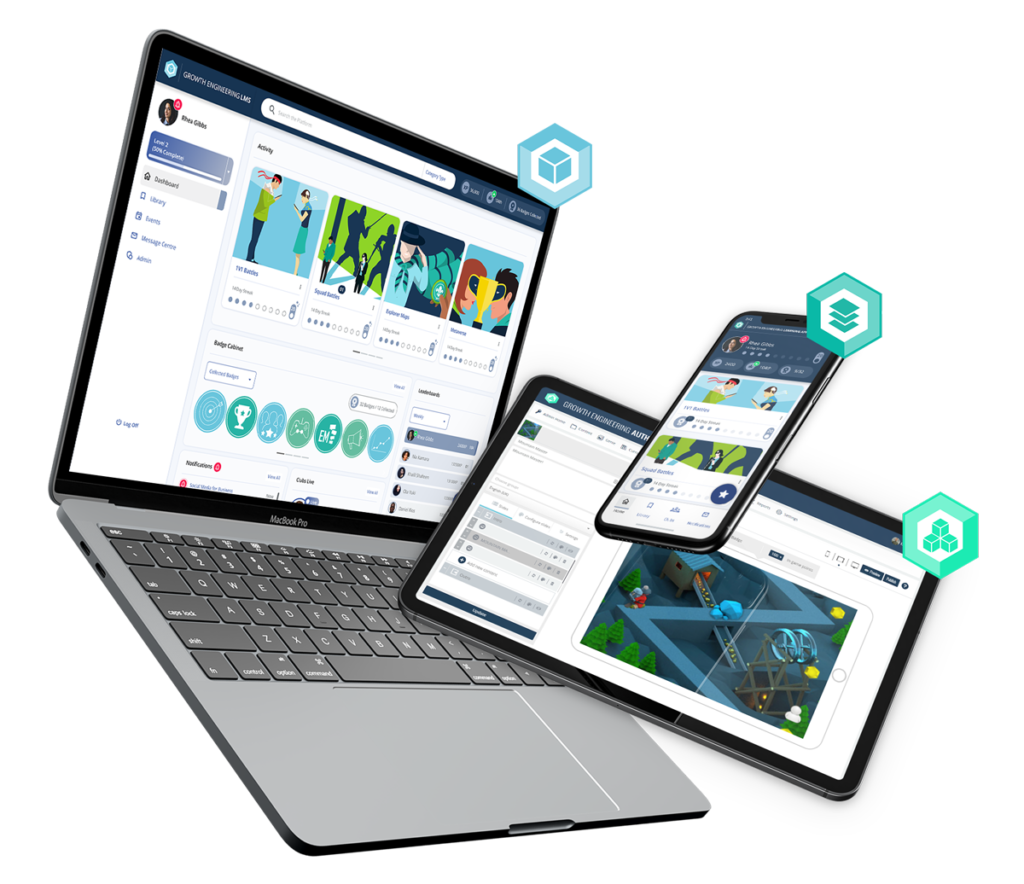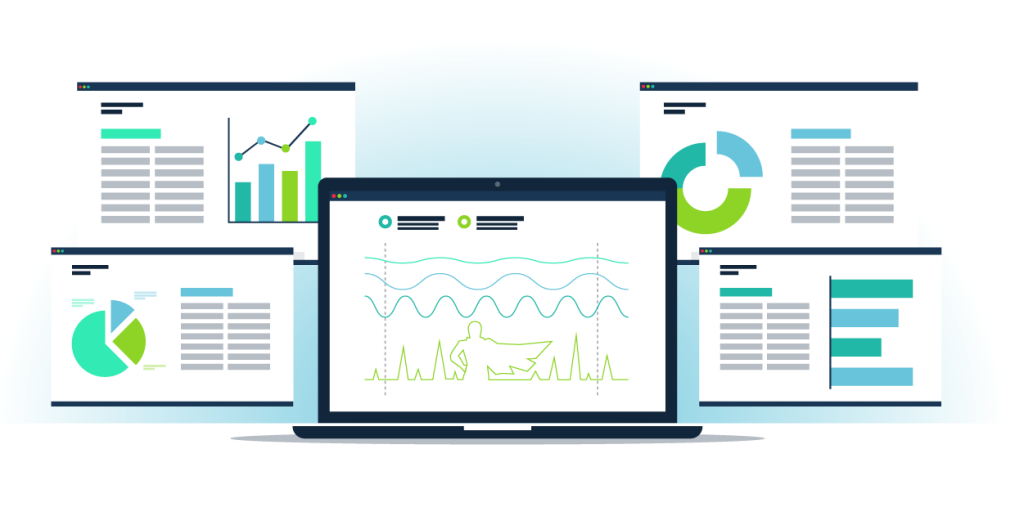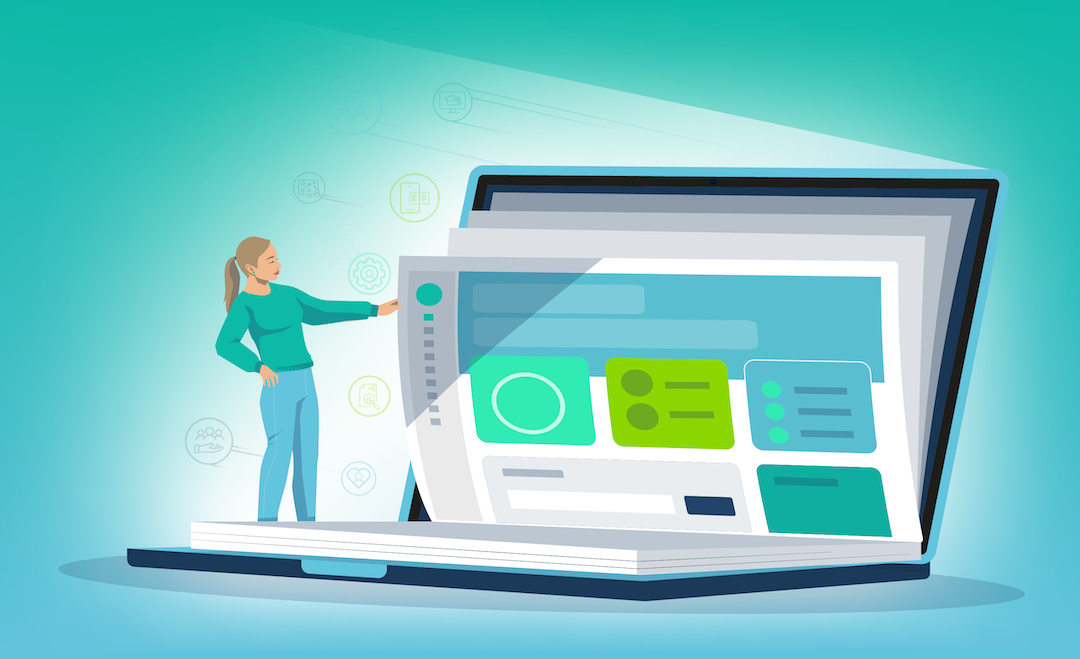If you pop your head inside any L&D department, you’re likely to overhear managers talking about learning objectives and KPIs. These fall under the broader umbrella of ‘goals’ or ‘targets’.

Ultimately, they’re intended to keep every employee more focused on their tasks than a cat on a laser pointer.
There’s an interesting relationship between goals and performance. In fact, a Harvard study once found that people who write down their objectives can be up to 10x more successful than those who don’t.
There’s just one problem. This study never actually happened! Thankfully, a real study found that committing to written goals and regularly updating your progress towards them really does let you accomplish a lot more.
In this article, we’ll be breaking down what exactly objectives and KPIs are. We’ll then apply our customary learning focus and look at how to properly define your learning objectives! Let’s get going!
Objectives and KPIs
Before we go any further, let’s just make sure you’re crystal clear on exactly what we’re talking about! Here’s the difference between objectives and KPIs.
Objectives
These are your overarching goals, or the big things you need to achieve. For example, an objective for a salesperson would likely involve increasing sales revenue by a set amount or achieving a set number of new clients.
An objective for a marketer could be to improve inbound leads, SEO performance or overall website metrics.
It’s important to note that an objective and a goal are not the same thing. An objective is much more specific and easier to measure than a goal. They’re SMART. This stands for Specific, Measurable, Achievable, Realistic and Timebound. We’ll get into this more later!
On the other hand, a goal is what you envision. For example, you may want to become the number one car dealership in the country or overtake a certain competitor. They’re quite broad, intangible and aspirational.
Once you’ve got a goal, you can then select specific objectives to help guide your progress.
Speaking of setting an objective, when doing so, it’s crucial to think about them in three key parts.
Part One – What Are You Trying to Achieve?
You need to think about where you want your company to end up. Sure, you might want to be the top car dealership in the country, but how are you going to achieve that?
Your objective needs to be geared towards this aim. Here’s where you can start getting specific. For instance, ‘increase the number of same-day contract signings by 30%’ or ‘recruit 40 new staff’ so there are more people on deck to help achieve your goal.
By doing this, there’s a clear path you can work towards. This will help you keep focus on your goal. You’ll also be able to clearly see where you’re making progress and where you’re playing catch-up.
Part Two – Why Are You Trying to Achieve This?
You’ll also need to pinpoint what the drive behind your goal is. As Simon Sinek says, ‘start with why’.
It could be a personal goal. It could be a desire to become financially stable. Or perhaps you’re endeavouring to make the world a better place. Maybe it’s a mix of all of those things.
Self-determination theory (SDT) is pretty helpful here. The theory looks at how the interplay between extrinsic (outside) factors, intrinsic (inside) motives and our personal needs pushes us to achieve things.
Motivation is great. It can make people more eager to understand the objectives and goals you’ve set for the company. Unfortunately, it’s not always easy to come by. And this can cause big problems.
The University of California found that unmotivated employees are 31% less productive, have 37% lower sales, and are three times less creative than motivated employees. They’re also 87% more likely to quit, according to a study of over 50,000 people.
This is why the three needs of SDT are important — competence, relatedness and autonomy.
Competence refers to our need to feel a sense of mastery over our chosen course of action. Relatedness means wanting to feel valued within a community. And autonomy refers to your psychological desire for independence and self-governance.
Individuals need to meet these needs to become truly self-determined. These three needs are often the ‘why’ behind your goals. They’re a key driver to get you to where you want to be!
Part Three: What Makes a Good Business Objective?
As previously mentioned, goals are general and objectives are SMART. Even if the goal doesn’t seem all that important, it needs to be clear. Otherwise, how can you realistically work towards achieving it?
Objectives should be set at all levels in the company, regardless of size or age. These objectives aren’t just company targets. They should scale down to become team objectives, and individual objectives.
For example, at Growth Engineering, we set overall objectives for the company that feed into departmental and team objectives. This can then be used to inform individual objectives. It’s great for team morale and productivity!
When objectives are set in a way that makes them measurable, they’re an excellent framework against which to check your progress. But what’s the best way to check this progress? Here’s where KPIs come in!
KPIs
A Key Performance Indicator (KPI) is an individual task which needs to be completed in order to reach your general objective.
Let’s return to our salesperson example. They won’t be able to increase sales revenue without completing a number of tasks along the way. This could include making a certain number of prospecting calls or upselling a certain number of new products.
KPIs are quantifiable and that makes them a lot easier to track and target. It’s all well and good to want to increase website traffic. However, you need to follow SMART principles. An increase of 10 sessions each month isn’t a worthwhile target, whilst an increase of 10,000 sessions may be unrealistic.
Let’s look at a different example in more detail:
Objective – Decrease employee turnover rate by 25% by the end of this quarter.
- KPI 1 – Increase training hours per annum/per employee by 15%.
- KPI 2 – Introduce five new benefits that employees have shown an interest in via survey.
- KPI 3 – Reduce time to respond to an internal complaint to 48 hours.
These are all SMART and work towards the overarching objective.
Of course, it’s useful to set objectives and KPIs for every individual, so that they have a clear idea of exactly what they should be working towards. But don’t neglect departments or even the organisation as a whole!
KPIs come in different shapes and sizes. Here are four types of KPIs that you may wish to use throughout your organisation.
- Strategic: These KPIs look at the company as a whole. They are big picture KPIs. They’re measured to see how the organisation is performing. As such they include measurements such as ROI, revenue, share price and so on.
- Operational: An operational KPI will look at performance in a shorter time frame than a strategic KPI. They’re concerned with organisational processes and measure things like sales or travel costs each month.
- Functional Unit: Functional KPIs can be strategic or operational. The actual concern of this kind of KPI will depend on your department. Different departments will be interested in different measures. For example, a financial department KPI will look at ROI and overhead costs. Whereas a marketing department will focus on measurements like cost per lead and conversion rate.
- Leading vs. Lagging: A leading KPI will predict an outcome, while a lagging KPI will look at what’s already taken place. For optimal results, it’s best for your company to track a mix of both.
How to Set a KPI
That’s all well and good, but how do you actually choose which KPIs to track? Well, for a start, you need to make sure you’re looking at KPIs that are actually relevant. Here are six key steps:

- Define how your company will use KPIs: Simply put, KPIs need to be useful for those who’ll be tracking them. Make sure they’re valuable.
- Link them with strategic goals: Although KPIs can be specific to each department, they need to be contributing to achieving business objectives.
- Make them SMART: If you follow the SMART formula, you can’t go wrong. That way KPIs are clear, concise and easy to keep in mind.
- Keep them clear-cut: Everyone should be able to understand your KPIs, even if they’re in a different department.
- Intend to iterate: As time goes on, you may need to adjust your KPIs as business needs change. Some may become outdated, or as the business grows, some may no longer be ambitious enough. Make sure to review them constantly.
- Don’t set too many: It can be tempting to want to measure every single metric you can. However, this is not necessary. Focus only on the KPIs that are relevant to your objectives.
Overall, a KPI shows which direction the team should be heading towards, and gives everyone visibility of how their work is making an impact.
Think SMART
When writing an objective or KPI you need to be smart (haha) about it.
This little acronym is one to remember, as it will make sure that anything you set will actually be useful. Your objectives need to be:
- Specific – Make them clear and unambiguous.
- Measurable – Make sure you can track your progress, and put a number on your success.
- Achievable – They should stretch you, but not be out of reach.
- Relevant – They need to be tied to overarching business objectives and what you’re trying to achieve.
- Time bound – You need a deadline to get them done by.
Let’s look at the example from before — Decrease employee turnover rate by 25% by the end of this quarter.
This is specific because it focuses on employee turnover. It’s measurable because this is something which can be tracked. And it’s achievable because it will require hard work, but it’s not out of reach. It’s realistic because you already have the plans in place. Furthermore, it’s time-bound because it needs to be completed by the end of the quarter.
SMART goals turn everyone into well-oiled task-completing machines, incapable of leaving a job half-done! They’re great for productivity and employee morale. A study of over 250 people found that you’re 42% more likely to achieve an objective if you’ve noted it down.
As we focus on the world of learning, this begs the question: how can you use objectives and KPIs to elevate your training programme? Let’s take a look!
Four Top Tips To Help You Define Your Learning Objectives
Just like any other objective, learning objectives should also be SMART. In fact, they should follow all the best practice advice we’ve issued so far.
As a learning & development practitioner, you’ll need to set learning objectives at an organisational, departmental and individual level.
But you’ll also need to go further and set learning objectives at a content level. This ensures that each individual learning object serves a clear purpose. These objectives help learners to understand ‘WIIFM‘ and where they should be applying their focus.
Here are some example learning objectives that you might see attached to an eLearning module:
- By the end of this module, learners will be able to successfully describe the benefits of selling ethically.
- By the end of this module, learners will be able to successfully create new instructional content using the ADDIE process.
- By the end of this module, learners will be able to successfully demonstrate where our new product fits within our current range.
These objectives follow the standard SWBAT (‘students will be able to…’) format. You may also want to want to utilise Bloom’s Taxonomy to help you select suitable verbs for your learning objectives.
Let’s take a look at how to set them!
1. Start With a Clear Goal
This is the first and most important stage of creating a good learning objective. If you decide to skip this step, don’t be surprised if you don’t get fantastic results.

You need to be clear on what you want your training initiative to accomplish.
For example, you may want to make sure all employees receive training relevant to their job roles. From there you could determine your KPIs. For instance, conducting a learner survey, rallying your SMEs and releasing new department-specific modules at least once per month.,
The best way to find out what’s actually needed would be to conduct a training needs analysis. This will help you identify problem areas and adjust accordingly. And remember, any goals you set need to contribute to overall business objectives too!
2. Perform a Training Needs Analysis

Once you know where you want to end up, it’s time to work out how far along that road your learners are. A training needs analysis is what it sounds like — it’s the process of analysing your learners and the business as a whole to figure out which areas are in most need of training.
A training needs analysis takes into consideration things like past training initiatives, current applications and any upcoming changes to the organisation.
If you start planning a learning objective without knowing where your learners currently stand, you could end up wasting a lot of time creating training resources that nobody really needs. Worse still, you could miss that vital knowledge gap that’s potentially costing your business a small fortune.
3. Decide How the Learning Will Be Delivered
Once you’ve got a SMART goal worked out, and you know your training needs like the back of your hand, you can start figuring out how you’re going to deliver the training. At this stage, you should have a good idea of what’s possible in your training plan.
Let’s say you’ve got a world-beating, game-changing monster of a learning objective in your mind. This objective will change your organisational culture and it’ll make you look like such a hero, they’ll have a plaque with your name on it mounted on the front wall of your office.

On closer inspection, however, you realise that in order to achieve this objective, you’ll need to hire a bunch of instructors, build a futuristic training facility and install a high-tech 3D virtual simulator.
Although that would, admittedly, be pretty awesome, you might have a bit of trouble convincing your finance team to give you the budget. At this stage, you have two choices:
- Go back to your learning objective and, with tears in your eyes, start the process of paring it back.
- Research other ways to make your training dreams come true without the need of a hefty revenue injection.
We don’t want you to sacrifice your master plan just because of a prohibitive training budget, so the least we can do is help you out with point #2. You don’t need to spend a fortune to make effective training.
Here’s where Growth Engineering LMS and Growth Engineering Learning App can help! These platforms offer a bunch of features designed to help you achieve all your learning dreams. This includes gamification, social learning, personalised learning paths, levels and much more!
You can also create your very own modules, assessments and quizzes using Growth Engineering Authoring Tool. That way you can be sure that all your content is relevant to your objectives and is helping tick off KPIs.
4. Tracking Your Learning Objectives
Of course, you can’t just set an objective and then move on. You need to track your progress over time and monitor performance.

You should ensure that your objectives and KPIs are accessible to all relevant employees and that they are regularly updated and discussed. This gives your team an opportunity to evaluate their success and reprioritise as necessary.
This can also be achieved on an individual level. If your Reporting Suite tells you that a learner is struggling to achieve their training objectives, then their manager can reach out to provide additional support and motivation.
Benefits of Learning Objectives
Clearly stated learning objectives benefit you, your learners and your content creators.
This way there’s a defined path and sense of purpose all the way through your learning initiative. You can also see at what stage things are going wrong if an issue arises.
For learners, they have a clear sense of orientation. Furthermore, they can accurately decide on learning content that’s relevant to their role.
For trainers and authors, it’s easier to design the content needed when there’s a clear objective it needs to achieve.
Lastly, for admins and managers, they can use learning objectives as something to measure learner progress against. With that they can provide better feedback.
Feedback is vital. Did you know that companies that provide consistent employee feedback experience 14.9% lower turnover rates?
Final Words
Hopefully by now, you understand the difference between an objective and a KPI and just how important they are.
They set the tone and direction for your organisation. You need them to make sure you’re actually headed to where you want to go and don’t get lost along the way.
They’re important for all departments but especially useful when it comes to setting learning objectives.
Having clear objectives will help you to configure a training programme with real impact. Furthermore, it will give your learners a clear sense of direction and purpose.
Would you like to learn more about setting the right objectives for your training initiative? Download our Tip Sheet: ‘222 Impactful Instructional Design Tips’ today!








